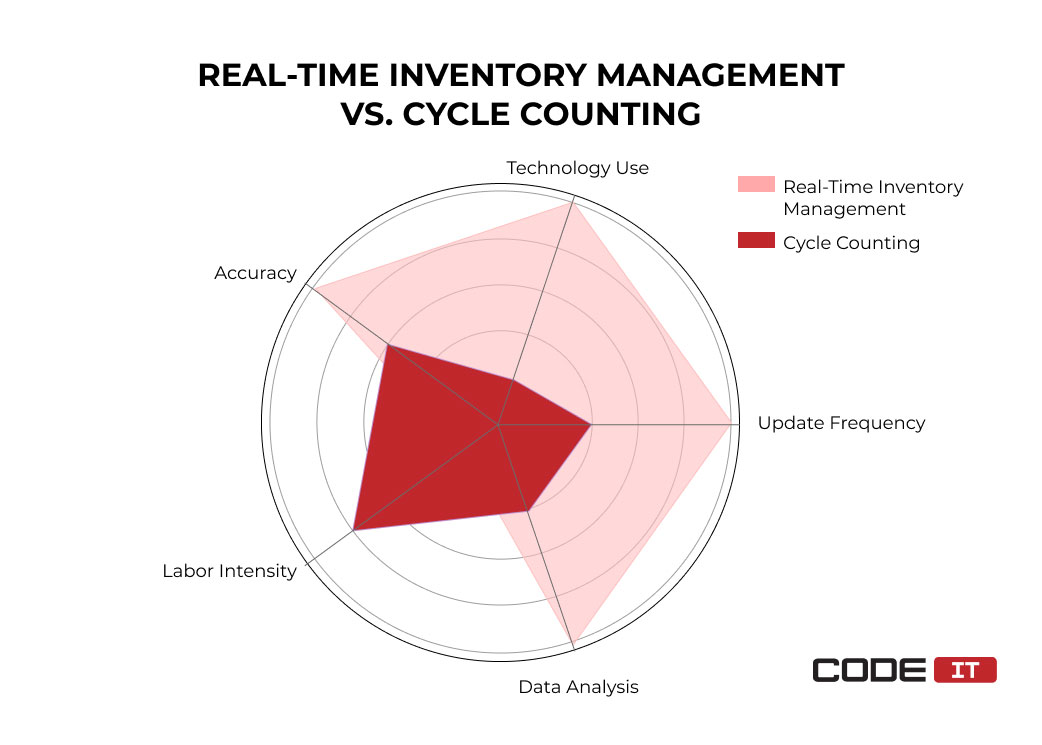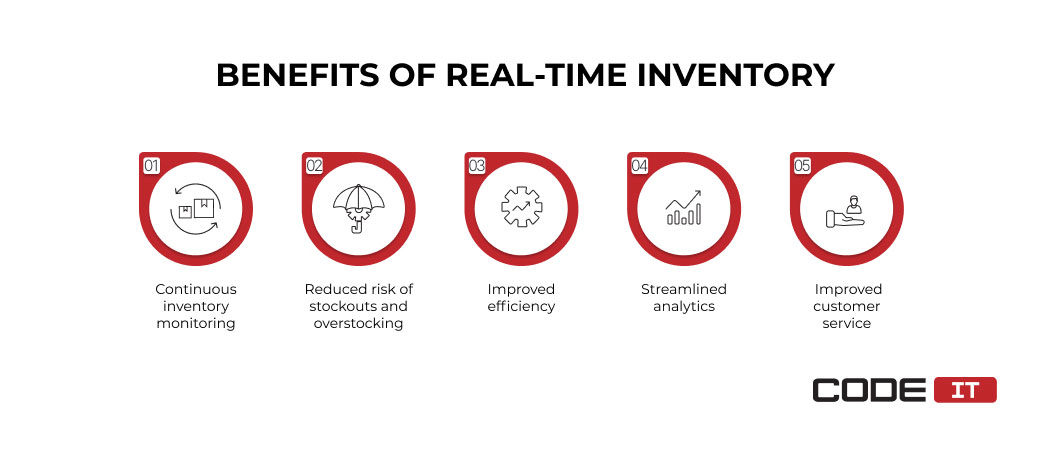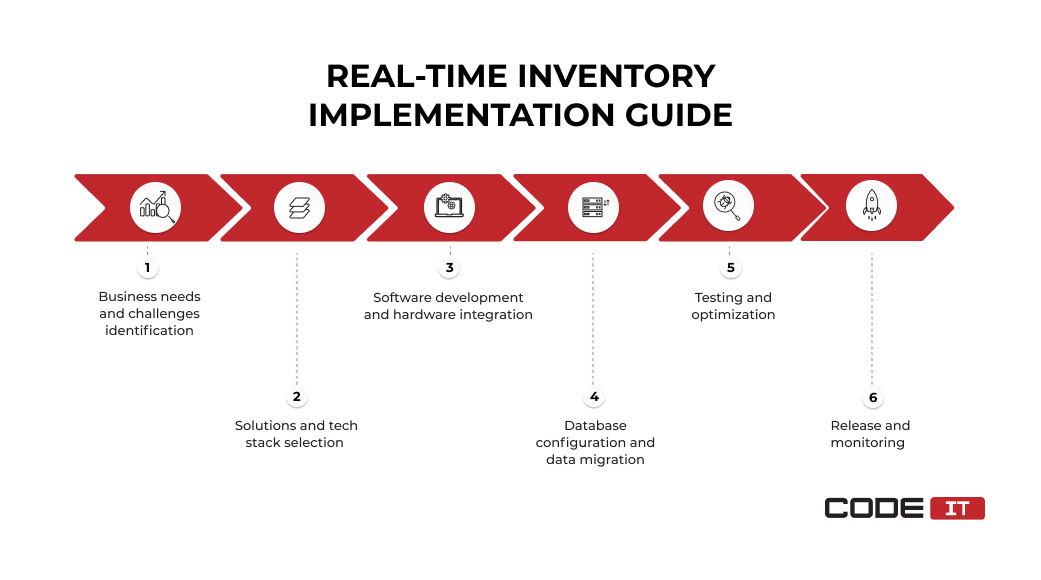Real-Time Inventory Management System — Development Guide + Technologies
A real-time inventory management system ensures instant data collection, processing, and sharing capabilities.
It helps eliminate the lag of information update, which occurs when applying manual cycle counting.
Statistics say that about 34% of retailers in the US have sold out-of-stock products because of a lack of real-time inventory management. Moreover, over 43% of American businesses track inventory manually using spreadsheets and cycle counting. It results in stockout, excess inventory carrying costs, and inaccurate forecasting.
REAL-TIME INVENTORY MANAGEMENT: BASIC FACTS
Real-time inventory management is enabled by advanced technological solutions. They help automatically identify and track packages, pre-process and update inventory data, present information, etc.
Real-Time Inventory vs Cycle Counting
The implementation of real-time inventory tracking helps enable automation and decrease the manual input significantly. In contrast to manual cycle counting, it helps achieve the following:
- better accuracy
- update frequency
- data analytics
- technology usage
Check out the chart highlighting the strong sides of real-time inventory management compared to cycle counting.

The key peculiarities that help distinguish real-time Inventory and production management software are:
- Simultaneous data update. All the data about in-stock and in-progress inventory is collected and transferred instantly. It may be pre-processed and visualized in time.
- High level of automation. The high level of technology adoption enables real-time data updates. Automated scanners, IoT, and cloud servers are the top tech solutions used in real-time inventory management systems.
- Full inventory and supply chain management. A data-sharing pipeline enables the opportunity to track the location of in-stock inventory. All data updates are delivered simultaneously and displayed on a dashboard.
- Third-party integration. Real-time inventory management software should be connected with ERP, CRM, and other systems to collect data comprehensively.
- Data-driven analytics. Inventory software can summarize and visualize data in live time. With the help of artificial intelligence (AI), businesses can extract valuable insights and forecast demand trend changes.
Build an advanced real-time IMS
Technologies
The top eight technological solutions that help enable real-time inventory management include the following.

1. RFID tags
Radio-frequency identification (RFID) technology enables the opportunity to issue and track small tags put on packages. The information on tags can be read a few to thirty feet away from an item.
An RFID tag may contain custom item details, including:
- SKU number
- Serial product’s number
- Name
- Location
- Weight
The amount of data an RFID tag can store varies from several bytes to two kilobytes.
2. Barcode and UDI scanners
Automatic UDI scanners help trace the movement of products. They can scan RFID tags, barcodes, and other UDIs. The scanned data and the item’s location information are sent to a server instantaneously.
3. Network
A network is usually implemented by using WiFi routers and wired connections. The other popular technologies for developing a network of devices are Bluetooth, cellular network, and near-field communication (NFC).
If several networks are connected in a warehouse, it’s advisable to implement a network getaway. It is responsible for device authentication and traffic routing.
4. Edge computing
Additional server nodes integrated into a network present the edge computing layer. They can pre-process inventory data and send commands without transmitting data to the main server.
The implication of edge computing helps:
- reduce the amount of data transferred over the network
- improve inventory data processing speed
- reduce the workload on the main server
- optimize data storage
- improve system scalability
Edge computing helps enable real-time inventory management in large-scale enterprises that need to process large amounts of data without delay.
5. Cloud servers
Cloud servers are dedicated computers that can be accessed virtually. They can store and process inventory data remotely. Third-party vendors maintain all the hardware of cloud servers.
All the inventory data collected by a company can be sent to a cloud and processed instantly. The reports and real-time dashboard can be accessed from any location online.
6. Data mapping tools
The inventory data collected by different devices can have different types and formats. Additional data validation and transformation may be required to enable automatic information flow and analysis.
Data mapping tools can check and transform data in real time. Also, they enable the opportunity to create custom data transformation rules to connect solutions from third-party vendors.
7. API integrations
Third-party software may be required to connect for gathering inventory and sales data to a centralized repository. The top real-time inventory management system integrations are as follows.
- Enterprise resource planning (ERP) systems
- Customer relationship management (CRM) software
- Point of sale (PoS) systems
- E-commerce platforms
- Vendor and supplier portals
8. Internet of Things (IoT)
The Internet of Things (IoT) in a warehouse describes a set of interconnected smart devices. They help monitor inventory and control storage conditions remotely. All the data gathered by smart devices is instantaneously transferred to the main server. The most popular IoT devices that help enable real-time inventory management are:
- smart sensors
- GPS trackers
- AI cameras
- smart HVAC systems
Implement the top technologies with CodeIT
BENEFITS OF REAL-TIME INVENTORY MANAGEMENT
Real-time inventory management systems enable the opportunity to track all the changes instantaneously.

The main benefits include the following.
- Continuous inventory monitoring. Information about inventory levels and products in progress is collected and updated continuously. The main server pings connected solutions to maintain an active connection. New data is sent to the central server when inventory information is updated.
- Reduced risk of stockouts and overstocking. Inventory levels are continuously monitored and delivered to the main server without any lags. Responsible managers can rapidly detect in-stock products that fall below the defined points and submit replenishment requests.
- Improved efficiency. The implication of real-time inventory management helps reduce the manual input and enhance order fulfillment. Technology adoption promotes automation, reduces errors, and helps achieve better inventory accuracy.
- Streamlined analytics. Large amounts of data collected across a supply chain can be summarized and visualized in real time. Artificial intelligence (AI) helps detect hidden patterns and extract valuable insights.
- Improved customer service. The ability to access inventory data in real time and share it with customers/vendors decreases the chance of selling out-of-stock products.
HOW TO IMPLEMENT REAL-TIME INVENTORY MANAGEMENT
The adoption of real-time inventory management systems involves the adoption of hardware and software solutions. Also, they need to be connected to a centralized system.

Read about the six crucial steps to implement real-time inventory management.
1. Identify Business Needs and Challenges
Analyze the existing inventory management workflow. Detect bottlenecks or root causes of critical problems. Identify business goals and outcomes you want to achieve by implementing real-time inventory tracking and management solutions. Develop an implementation plan and outline a budget and deadlines.
Roles and responsibilities at the stage
- Stakeholders. Share information about business challenges and objectives.
- Business analyst. Analyze the workflows and business requirements and create a plan. Define functional and non-functional requirements.
- Tech specialist. Analyze existing infrastructure and identify tech capabilities.
Need to assess your business needs? Check out:
2. Pick Solutions and Technologies
Select the most optimal technologies to implement. Pick a tech stack for developing new software and define third-party services to integrate. Ensure that all the hardware and software can be connected to a centralized system.
Roles and responsibilities at the stage
- Solution architect. Pick a tech stack, hardware, and third-party integrations. Select the most optimal infrastructure solution.
- Project manager. Check the scope of work and the documentation.
- Business analyst. Provide assistance in analyzing documentation and business requirements. Communicate with stakeholders upon a need.
3. Integrate Hardware and Develop Software
Onboard a team of developers and engineers. Develop real-time inventory management software and integrate additional services via API. Install the required hardware and integrate it with the software solution. Additional data mapping tools may be necessary to incorporate hardware from different vendors.
Roles and responsibilities at the stage
- Software developers. Create new software systems and integrated solutions from third-party vendors.
- Engineers. Install inventory tracking hardware and configure it.
- Project manager. Coordinate processes and monitor task completion.
Read also:
4. Configure a Database and Migrate Data
Install and configure the infrastructure for running software solutions and storing inventory data. Adjust the infrastructure in accordance with the business needs and maximum inventory capacity.
Migrate all the inventory data to a new system. Conduct a comprehensive check to ensure no data was damaged, deleted, or transferred during the migration process.
Roles and responsibilities at the stage
- Software developers. Configure a cloud-based or on-premises server. Migrate inventory data.
- Project manager. Manage infrastructure setup and data migration processes.
5. Test and Optimize
Ensure the developed system works correctly and bug-free. Identify possible flaws in the developed software and fix them. Analyze the system and optimize data processing and sharing workflows.
Roles and responsibilities at the stage
- Quality assurance (QA) specialists. Conduct manual and automated testing. Compose reports on detected bugs.
- Software developers. Analyze reports composed by QA specialists and fix detected bugs.
- Project manager. Manage tasks and monitor team performance.
6. Release and Monitor
Make a new system available for usage. Conduct a workshop to educate staff on using a new system and prepare instructions. Monitor the performance of the released real-time inventory management system to ensure no unforeseen issues occur.
Roles and responsibilities at the stage
- Software developers. Release software and monitor performance.
- Project manager. Manage the go-live process.
- Stakeholders. Conduct acceptance testing.
Read also:
REAL-WORLD EXAMPLES
The top companies that have adopted real-time inventory management systems and solutions they have implemented are as follows.
| Amazon | Walmart | FedEx | Home Depot | Best Buy |
| Cloud-based storage | Electronic data interchange system | Automated barcode and RFID tag scanning | Multiple-storage inventory tracking | CRM software integration |
| AI-driven data analysis | Automated RFID tags issuing and scanning | Start-to-finish package tracking | Predictive analytics for demand change identification | Cloud-based inventory management infrastructure |
| Continuous package tracking | Integrated warehouse management system | GPS-driven real-time inventory tracking | RFID tags tracking for real-time inventory data collection | Real-time data analysis |
| Scanless package identification |
CONCLUSION
A real-time inventory management system enables the opportunity to monitor data about products continuously and receive updates instantaneously.
The main peculiarities of real-time inventory are:
- simultaneous data update
- high level of automation
- full inventory visibility
- third-party integration
- data-driven analytics
The adoption of integrated software solutions and automation is required to enable real-time inventory visibility and management. The key technologies include the following.
- RFID tags
- Barcode and UDI scanners
- Network
- Edge computing
- Cloud servers
- Data mapping tools
- API integrations
Enable real-time inventory management
Real-time inventory software enables the opportunity to monitor all the updates in a warehouse without a time lag. All inventory data flows continuously via defined pipelines.
Real-time tracking is enabled by automatic scanners that track the movement of products in a warehouse. All the data about inventory items’ location and status is sent to the main server simultaneously. It is processed and visualized in real-time by using business intelligence (BI) systems.
Real-time inventory management is enabled by adopting technologies that track inventory automatically. The top technologies that help enable real-time inventory tracking are:
- RFID and barcode scanners
- Cloud servers
- Data mapping tools
- Networks
- Internet of Things (IoT)
Follow the six steps for developing real-time inventory management software.
- Business needs identification
- Tech stack and solutions definition
- Hardware integration
- Database configuration and data migration
- Solution testing and optimization
- System release and monitoring
The core benefits of real-time inventory management are:
- Continuous inventory monitoring
- Reduced risk of stockouts and overstocking
- Increased performance
- Streamlined analytics
- Improved customer service